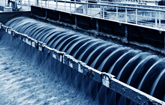BOSTON, April 22, 2020 /PRNewswire/ -- Data can drive insights, increase efficiency, and provide detailed information about current water and wastewater networks. The water industry is one which has many unknowns, and more data can provide help to this mature and large industry. The new report from IDTechEx, "Digital Water Networks 2020-2030," provides a holistic overview of the opportunities and forecasts this market to grow to over $2Bn by 2030.
In the next decade, digital solutions will provide a way for utilities companies to monitor their networks in a variety of different ways. This report discusses six main groups of sensors which can provide these insights: water flow meters, water level meters, temperature sensors, pressure sensors, acoustic sensors and chemical sensors. Within these groups, different types of each sensor are discussed, and their benefits and drawbacks for different situations shown.
For example, water flow meters provide an excellent method to track the flow in pipes, providing parameters such as the mass flow or volumetric flow rate. In water pipes, these could be invasive, as these pipes are typically full, and are clean so have no solid particles to filter out. However, an invasive method requires passing stringent requirements for health and safety and, therefore, it may be more beneficial to have a non-invasive method which can calculate the flow speed through pipes.
Cost is a key factor with these sensors, and with some sensors requiring large holes to be dug to put them into the water network, the trade-off has to be long enough for a utilities company to reap the rewards of a data-driven network. With sensors now lasting up to 10 years, this provides an excellent opportunity for pipe networks to be upgraded and provide continuous monitoring. This report provides a concise and informative overview of the different applications and use cases of the various sensors currently available for market, which can be used for monitoring water and wastewater networks.
Not only does the cost matter, but different countries have different regulations which determine the priority of what sensors are more likely to be put into their networks. For example, if leaks are a priority, then leak identifications solutions would have higher demand. This report provides a range of case studies which show the different ways that countries, companies, or joint ventures, have implemented smart water and digital water techniques and technology into their networks.
This report provides comprehensive information on various processes, sensors, in systems offered by the top players in the water and wastewater treatment markets. The holistic overview includes industry analysis, a detailed summary of how each of the sensor groups can impact specific aspects of both the water and wastewater industries, and where the opportunities and hype will take this exciting technology in the coming decade. For more information on the report please visit www.IDTechEx.com/DigitalWater or for the full portfolio of sensors research available from IDTechEx please visit www.IDTechEx.com/research/Sensors.
To connect with others on this topic, register for The IDTechEx Show! USA 2020, November 18-19 2020, Santa Clara, USA. Presenting the latest emerging technologies at one event, with six concurrent conferences and a single exhibition covering 3D Printing and 3D Electronics, Electric Vehicles, Energy Storage, Graphene & 2D Materials, Healthcare, Internet of Things, Printed Electronics, Sensors and Wearable Technology. Please visit www.IDTechEx.com/USA to find out more.
IDTechEx guides your strategic business decisions through its Research, Consultancy and Event products, helping you profit from emerging technologies. For more information on IDTechEx Research and Consultancy, contact [email protected] or visit www.IDTechEx.com.
Media Contact:
Jessica Abineri
Marketing Coordinator
[email protected]
+44-(0)1223-812300
SOURCE IDTechEx

Related Links
WANT YOUR COMPANY'S NEWS FEATURED ON PRNEWSWIRE.COM?
Newsrooms &
Influencers
Digital Media
Outlets
Journalists
Opted In






Share this article